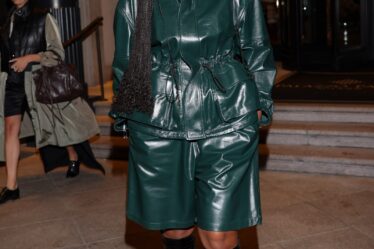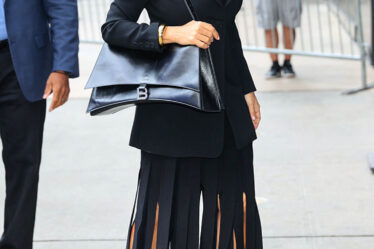

It’s BoF Careers Week 2023, when we shine a spotlight on careers advice, insights and inspiration to help you make your next career move. Discover the latest job opportunities, with 2,600+ roles on BoF Careers today.
Collaborative work environments are conducive to the creative process. A recent Adobe survey of over 1000 creatives reveals that 79 percent of creators across the UK, France and Germany consider collaboration to be a critical part of the creative process, rather than working in a silo.
Merging the different expertise of professionals with complementary skill sets, nuanced insight and varying lived experience can improve creative output and can innovate often outdated ways of working. Critically, collaboration can also foster greater compassion within a business, as employees better understand how their colleagues work, and what their priorities and needs are, enabling more efficient execution long-term.
“The best ideas come when everybody’s in a room, physically or digitally, bouncing ideas off each other and building on one concept,” says Nabil Aliffi, chief brand officer at Neiman Marcus Group, parent company to luxury retailers Neiman Marcus and Bergdorf Goodman, who has previously served in executive creative roles at Soho House, Selfridges and Urban Outfitters.
“In many places, the creative team is in service of merchandising or other areas of the business, so making sure that team members are supported in making those connections and having those relationships within the creative team — but also externally — is essential,” he adds.
“It is about creating other opportunities from your job objectives, being able to push your ideas and elaborate on them. Creating a pathway for yourself is key,” said Rajni Jacques, Snap Inc.’s global head of fashion and beauty partnerships, in an interview with BoF last year. “I look for those abilities within people that I hire.”
Now, BoF Careers shares insight and advice from leading creatives, fashion executives and recruitment and training consultants on how those in creative, operational and commercial roles can improve their cross-functional collaboration skills to further their career in fashion.
Align Around Your Company’s Core Values and Audience
Productive work environments are ones where teams and individuals are aligned on their organisation’s core values, its consumer audience as well as their own role in delivering value to them on behalf of the business. Core values are the bedrock of successful creative collaboration and innovation.
“The best way to [immerse yourself in your organisation] is to understand the remit of [your supervisors’] expectations and then work within the parameters of that remit,” says Paul-Christian Bassett, chief executive of his namesake recruitment and executive training consultancy, which works with luxury brands such as LVMH, Alexander McQueen and Loro Piana across Europe and the APAC region.
Referring particularly to more junior designers, Bassett adds that “if you understand where that brand wants to go with the creative direction, and you can design within that, you are going to be very well received.”
“Making sure that you have the right starting point will help inform or anchor the concept,” he adds. That alignment enables “different stakeholders in your organisation […] to either refute your initial hypothesis about the concept or strengthen your initial assumptions. […] It is definitely not an individual process.”
Make an Impression Outside Your Main Function
Those who cultivate relationships outside their area of responsibility often stand a better chance to excel within their business or area of focus, as they gain an overall sense of their organisation’s mission, the different players working towards achieving it and how they are doing so.
You can identify in company meetings or presentations where you might be able to share your insight or know-how, and reach out to coworkers to ask about their roles, priorities and processes, to learn if and how you can support their work in a respectful and curious manner. Initiating a knowledge exchange rather than a down-to-business interaction will facilitate a more approachable way of working.
These connections also fuel innovation since they facilitate idea exchanges between employees with complementary skill sets. As an added bonus, such exchanges also increase employee satisfaction and engagement. According to a report by management consultancy Gallup in 2020, high levels of employee engagement lead to a 20 percent upsurge in both productivity and profitability, as well as a 24 percent drop in employee turnover.
“To hiring managers, you are seen as a viable team player who is liked across functions if you develop good relationships with those in product development, collection merchandising, retail, whatever it is,” says Bassett. “That is going to help you in the future — connections are critical for your career and advancement, [whether] for references, [or when people] naturally drop your name in conversation at lunch — so the benefits are obvious.
“The more people like you, the more people are singing your praises; the more effective you are communicating, the higher visibility you are going to have. These are the people who do well and climb the ranks really quickly,” he adds.
The best ideas come when everybody’s in a room, physically or digitally, bouncing ideas off each other and building on one concept.
Managing these relationships can support your career development not only by acquiring the necessary soft skills to succeed but also by enabling you to reflect on where you are headed.
“Working in a creative industry [and] working in fashion, it is truly meant for collaborations,” said Snap Inc.’s Jacques. “As you go through, you learn, you try things — ‘that is not meant for me, or that is exactly what I want to do’ — you can feel in your gut when things are working well or when things feel right. It is all trial and error.”
Be Empathetic and Open to Communication
Creatives often need to work with other creative disciplines, as well as commercially driven colleagues and a huge range of support functions whose ideas and experience can enhance output far more than simply achieving profitability. Doing so successfully requires patience with alternative ways of working.
“The personalities of people on the commercial and the creative sides can differ greatly, so there is a need for fine-tuning your communicative skills,” says Bassett. “One thing I learnt over the years is to be empathetic. If you want to challenge [others] or their ideas, empathise with them first and say, ‘What a great idea — I was also thinking…’ That way you agree to some extent and they are much more likely to react in a positive way.”
For instance, creatives need time to ideate and conceptualise, while commercial teams typically have explicit KPIs and metrics to meet on a regular basis, placing time pressure on their activities. This can create tension between the different parties’ approaches, and requires all to show sensitivity and empathy.
“When you are moving at 100 miles per hour, sometimes there can be crossed wires or conversations get difficult. But when you assume positive intent, it takes some of that pressure out of those conversations and you can focus on problem-solving,” says Aliffi of Neiman Marcus Group.
The Brain Trust approach is a useful framework for considerate peer reviews, whereby a small, diverse group of trusted coworkers share their expertise, insight and advice to generate new ideas or offer solutions to a given problem. They range in seniority, professional functions and approach, yet they all have an equal say in the discussion, making it efficient and solution-oriented.
“Be self-assured and take the time to actually learn what the other departments are doing. What pressures are they under? What are they being asked by the high management to achieve? That mutual understanding of where you both are can bridge gaps in personality,” says Basset.
“Collaboration is a muscle that you have to exercise because a lot of it has to do with how you interact with another human,” adds Aliffi.
Seek Out and Act Upon Constructive Criticism
One fundamental component of a successful, collaborative culture is trust. Namely, trust that your opinions are valued and considered as you work towards a shared goal, and trust that your colleagues have your — and the business’ — best interest in mind. To foster such an environment, seek out co-workers’ feedback, advice and constructive criticism to improve the quality of your output and expand your skill set.
“If you can take constructive criticism […] and understand [that your manager is] trying to help you, you can learn and become better,” says Bassett. He advises talent to deny the urge to self-defend and instead think and implement their managers’ or colleagues’ notes. “As a recruiter, when someone can take constructive criticism, it is gold dust,” he adds.
Building trust and productivity within a team also falls to managers. Gallup research found that 70 percent of the variation in a team’s engagement, which can predict its productivity, is within managers’ span of control.
“We are in the business of relationships, and we try to model that in the way we [work by] treating each other with respect, appreciating different points of view. As a creative, I know what I know, but I also need to, not just advocate, but inquire,” says Aliffi.
Take the time to learn what the other departments are doing. What pressures are they under? […] That mutual understanding of where you both are can bridge gaps in personality.
Constructive criticism can open you up to different ways of thinking or approaching a project, offering additional perspective on the task at hand and helping colleagues think differently.
“With trust, there is greater appetite to try new innovations. When you have that trust, if you want to [try] out-of-the-box ideas which might mean that we take a certain calculated risk on the types of products that we buy, that is built on a foundation where we can rely on each other and there is transparency, and at the end of the day, accountability for whatever the outcome is,” Aliffi adds.
Consider and Support Neurodivergent Talent
About 14 percent of the general population are neurodivergent — a term that relates to people with variations in their mental functions, such as autism, dyslexia, dyspraxia and ADHD — yet over 20 percent of the creative labour force is neurodivergent, according to The British Interactive Media Association’s Tech Inclusion and Diversity Report from 2019. This data should be taken into consideration when teams collaborate cross-functionally.
Dyslexia specifically affects about 9 to 12 percent of the global population, according to The European Dyslexia Association. “Three weeks into a PR internship, I was sacked because […] I am very dyslexic, so I could not handle the emails,” said Off-White art and image director, and Dazed editor-in-chief Ib Kamara in a previous interview with BoF.
“Emails are extremely difficult to manage when you struggle to read. So, I have always made that clear and would say, ‘Hey, I’m dyslexic, so please forgive my grammar or spelling mistakes.’ English is also not my first language. I would introduce myself and my flaws and ask people to let me know if they cannot read something properly,” added Kamara.
Outside of difficulty with reading and writing, “neurodiversity also affects organisational skills, which is a big part of the operational side of things,” says Jake Posner, founder and creative director of streetwear brand No One True Anything, who is also an ambassador of the British Dyslexia Association. “Hiring managers need to definitely be aware of it,” he adds.
As the fashion industry becomes more cognisant of neurodiversity, it is imperative to make necessary adjustments to include neurodivergents’ storytelling and design power, says Posner. But “There has to be some sort of lenience. […] What we can offer [when] introduced into a business, whether that be within a fashion setting or [not], how we can give our ideas and implement structures — it is invaluable.”
Establish a Flexible and Inclusive Work Environment
While remote or hybrid work models have now become the norm, many creatives find collaborating under these conditions increasingly taxing. In fact, collaboration is one of remote employees’ top challenges according to Forbes, as they have fewer opportunities to feed off one another spontaneously — a vital component of creative work.
Collaboration is a muscle that you have to exercise because a lot of it has to do with how you interact with another human.
Consequently, the “New Normal” saw many fashion companies rethink and remodel the purpose and layout of their office spaces, now used to encourage and accommodate collaboration as well as facilitate face-time with senior leaders.
“We do not want to lose all the things that make you develop deeper relationships like eye contact and non-schedule conversations,” says Aliffi. “We always try to make time that is not ‘productive’. I feel passionate about this with creative, [ensuring] there is time for just riffing, there is time for spontaneity. Creating space to allow for randomness to come in keeps the work alive and it is not a production line.”
Bassett says it is up to managers to model an organisation’s culture: “Personality will trickle down throughout the whole business. On a macro level, in the different divisions and departments, the leader in that studio will affect the creative direction. It affects the whole synergy, momentum, energy — and positive energy is the name of the game.”
Managers and executives should encourage their reports to enjoy downtime — and lead by example — since research shows most people get their best ideas when their brain is relaxed. Walks demonstrably boost creativity, particularly if done in nature, and enhance problem-solving abilities by 50 percent, according to the National Institutes of Health.
Disclaimer: Interviews have been edited and condensed for clarity.



